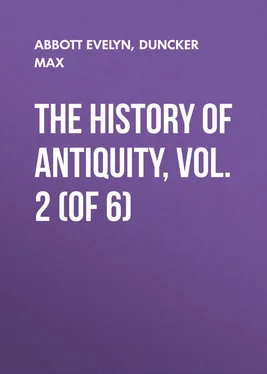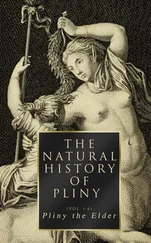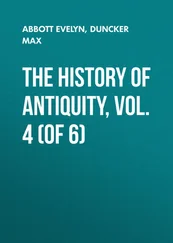Evelyn Abbott - The History of Antiquity, Vol. 2 (of 6)
Здесь есть возможность читать онлайн «Evelyn Abbott - The History of Antiquity, Vol. 2 (of 6)» — ознакомительный отрывок электронной книги совершенно бесплатно, а после прочтения отрывка купить полную версию. В некоторых случаях можно слушать аудио, скачать через торрент в формате fb2 и присутствует краткое содержание. Жанр: foreign_antique, foreign_prose, Историческая проза, на английском языке. Описание произведения, (предисловие) а так же отзывы посетителей доступны на портале библиотеки ЛибКат.
- Название:The History of Antiquity, Vol. 2 (of 6)
- Автор:
- Жанр:
- Год:неизвестен
- ISBN:нет данных
- Рейтинг книги:4 / 5. Голосов: 1
-
Избранное:Добавить в избранное
- Отзывы:
-
Ваша оценка:
- 80
- 1
- 2
- 3
- 4
- 5
The History of Antiquity, Vol. 2 (of 6): краткое содержание, описание и аннотация
Предлагаем к чтению аннотацию, описание, краткое содержание или предисловие (зависит от того, что написал сам автор книги «The History of Antiquity, Vol. 2 (of 6)»). Если вы не нашли необходимую информацию о книге — напишите в комментариях, мы постараемся отыскать её.
The History of Antiquity, Vol. 2 (of 6) — читать онлайн ознакомительный отрывок
Ниже представлен текст книги, разбитый по страницам. Система сохранения места последней прочитанной страницы, позволяет с удобством читать онлайн бесплатно книгу «The History of Antiquity, Vol. 2 (of 6)», без необходимости каждый раз заново искать на чём Вы остановились. Поставьте закладку, и сможете в любой момент перейти на страницу, на которой закончили чтение.
Интервал:
Закладка:
Can we fix the time at which the Phenicians first set foot on the islands of Hellas? Herodotus tells us that Troy was taken in the third generation after the death of Minos. 136 136 Herod. 7, 171.
If we put three full generations, according to the calculation of Herodotus, between the death of Minos and the conquest of Ilium, the first event took place 100 years before the second. Since, according to the data of Herodotus, the capture of Ilium falls in the year 1280 or 1260 B.C., Minos would have died in the year 1380 or 1360 B.C. The landing of the Phenicians on Thasos and the expedition of Cadmus from Phœnicia beyond the islands to Bœotia are placed by Herodotus five generations before Heracles, and Heracles is placed 900 years before his own time. If we reckon upwards from the year 450 or 430 B.C., Heracles lived about the year 1350 or 1330 B.C., and Cadmus five generations, i. e. 166⅔ years, before this date, or about the year 1516 or 1496 B.C. 137 137 Herod. 2, 44, 145.
On the island of Thera, Herodotus further remarks, the Phenicians whom Cadmus left behind him there had dwelt for eight generations, i. e. 266⅔ years, before the Dorians came to the island. 138 138 Herod. 4, 147.
Melos was also occupied by Dorians, who asserted in 416 B.C. that their community had been in existence 700 years, 139 139 Thuc. 5, 112.
according to which statement the Dorians came to Melos in the year 1116 B.C. With this event the Phenician rule over the island came to an end. If we assume that Thera, which is close by Melos, was taken from the Phenicians by the Dorians at the same time as the latter island, the eight generations given by Herodotus for the settlements of the Phenicians on Thera would carry us back to the year 1382 B.C. (1116 + 266⅔), a date which is certainly in agreement with his statement about the death of Minos, but contradicts the date given for Cadmus, who yet, according to the narrative of Herodotus, left behind the settlers on Thera and Thasos when he first sailed to Bœotia. Herodotus fixes dates according to generations and the genealogies of legend. The five generations which separated Cadmus from Heracles were for him, no doubt, Polydorus, Labdacus, Laius, Œdipus and Polynices; for the three generations between the death of Minos and the capture of Troy we find in Homer only two, Deucalion and Idomeneus. 140 140 Herod. 5, 89; "Il." 13, 451; "Odyss." 19, 178.
But we can still find from Herodotus' calculations how far back the Greeks placed the beginning and the end of the empire of the Phenicians over their islands and coasts. Beyond this the chronographers do not give us any help. Eusebius and Hieronymus (Jerome) place the rape of Europa in the year 1429 or 1426 B.C.; the rule of Cadmus at Thebes in the year 1427 B.C. or 1319 (1316) B.C.; the settlement of the Phenicians on Thera, Melos, and Thasos in the year 1415 B.C.; the beginning of the rule of Minos in the year 1410 B.C., or, according to another computation, in the year 1251 B.C. 141 141 Euseb. "Chron." 2, p. 34 seqq. ed. Schöne. Even in Diodorus, 4, 60, we find two Minoses, an older and a younger.
We can hardly obtain fixed points for determining the time of the settlements of the Phenicians in the Ægean sea. In the lower strata of the excavations at Hissarlik, on the coast of Troas, clay lentils have been found with Cyprian letters upon them. 142 142 Lenormant, "Antiq. de la Troade," p. 32.
Since the Greeks declared that they learnt their alphabet from the Phenicians and Cadmus, and since as a fact it is the alphabet of the Phenicians which lies at the root of the Greek, the Cyprian letters can only have been brought thither by Phenician ships from Cyprus before the discovery of the Phenician letters, or from the islands off the Trojan coast occupied by the Phenicians, from Lemnos, Imbros and Samothrace; otherwise they must have come to the Troad at a later time by Cyprian ships or settlers, a supposition which is forbidden by the antiquity of the other remains discovered with or near the lentils. Among the sons of Japheth, the representative of the northern nations, Genesis mentions Javan, i. e. the Ionian, the Greek; and enumerates the sons of Javan: Elisha, Tarshish, Chittim, and Dodanim or Rodanim – the reading is uncertain. 143 143 Genesis x. 2-4: 1 Chron. i. 5-7.
It is a question whether the genealogical table in Genesis belongs to the first or second text of the Pentateuch, i. e. whether it was written down in the middle of the eleventh or of the tenth century B.C. In any case it follows that in the beginning of the eleventh or tenth century B.C. the name and nation of the Ionians was known not only in the harbour-cities of Phœnicia, but in the interior of Syria, and the inhabitants of the islands and of the northern coasts of the Mediterranean were reckoned in the stock of these Ionians. Chittim is, as was remarked above, primarily the island of Cyprus; the Rodanim are the inhabitants of Rhodes (Dodanim would have to be referred to Dodona); Elisha is Elis in the Peloponnese, or the island of Sicily, if the name is not one given generally to western coasts and islands; 144 144 Kiepert, "Monatsberichte Berl. Akad." 1859.
Tarshish is Tartessus, i. e. the region at the mouth of the Guadalquivir. If Ezekiel mentions the purple which the Phenicians bring from "the isles of Elishah," 145 145 Ezek. xxvii. 7.
the islands and coasts of the Ægean sea are plainly meant, on which the Phenicians collected the fish for their purple dye. This much is clear, that at least about the year 1000 B.C. not only the islands and coasts of the Ægean were known in Syria, but even then the name of the distant land of Tarshish was current in Syria. We shall further see that as early as 1100 B.C. Phenician ships had passed the straits of Gibraltar. Hence we may conclude that the Phenicians must have set foot on Cyprus about the year 1250 B.C., and on the islands and coasts of Hellas about the year 1200 B.C.
Thucydides observes that in ancient times the Phenicians had occupied the promontories of Sicily and the small islands lying around Sicily, in order to carry on trade with the Sicels. 146 146 Thuc. vi. 2.
Diodorus Siculus tells us that when the Phenicians extended their trade to the western ocean they settled in the island of Melite (Malta), owing to its situation in the middle of the sea and excellent harbours, in order to have a refuge for their ships. The island of Gaulus also, which lies close to Melite, is said to have been a colony of the Phenicians. 147 147 Diod. v. 12.
On the south-eastern promontory of Malta there was a temple of Heracles-Melkarth, 148 148 Ptolem. 4, 3, 47.
the foundation walls of which appear to be still in existence, and still more definite evidence of the former population of this island is given by the Phenician inscriptions found there. The island, like the mother-country, carried on weaving, and the products were much sought after in antiquity. On Gaulus also, a name mentioned on Phenician coins, are the remains of a Phenician temple. Between Sicily and the coast of Africa, where it approaches Sicily most nearly, lay the island of Cossyra, coins of which bear Phenician legends. Along with a dwarfish figure they present the name "island of the sons," 149 149 Ai benim ; Movers, "Phœniz." 2, 355, 359, 362.
i. e. no doubt, the children of the sun-god whom we met with in Rhodes. On the east coast of Sicily there lay, on a small promontory scarcely connected with the mainland (now Isola degli Magnisi), the city of Thapsos, the name of which reveals its founders; Tiphsach means coming over, here coming over to the mainland. In the same way the promontory of Pachynus ( pachun means wart), further to the south, and the harbour of Phœnicus are evidence of Phenician colonisation. On the south coast of Sicily, not far from the mouth of the Halycus, the Phenicians built that city which is known to the Greeks as Makara and Minoa, or Heracleaminoa; the coins of the city present in Phenician characters the name Rus-Melkart, i. e. "head (promontory) of Melkarth." 150 150 Heracl. Pont. frag. 29, ed. Müller; Gesen. "Monum." p. 293; Olshausen, "Rh. Mus." 1852, S. 328.
Off the west coast of Sicily the Phenicians occupied the small island of Motye. 151 151 Thuc. 6, 2.
On this coast of the larger island, on Mount Eryx, which rises steeply out of a bald table land (2000 feet above the sea), they founded the city of Eryx, and on the summit of the mount, 5000 feet high, they built a temple to the Syrian Aphrodite. In Diodorus it is Eryx the son of Aphrodite who builds this temple; Æneas then adorns it with many votive offerings, "since it was dedicated to his mother." 152 152 Diod. 4, 83.
Virgil represents the temple as being founded on the summit of Eryx, near to the stars, in honour of Venus Idalia, i. e. the goddess worshipped at Idalion (Idial) on Cyprus by the immigrants from the East, who, with him, are the companions of Æneas. 153 153 "Æn." 5, 760.
The courtezans at this temple, the sensual character of the worship, and the sacred doves kept here (in a red one the goddess herself was supposed to be seen 154 154 Diod. 4, 83; Strabo, p. 272; Athenæus, p. 374; Aelian, "Hist. An." 4, 2; 10, 50.
), even without the Phenician inscriptions found there, would leave no doubt of its Syrian origin. The mighty substructure of the building is still in existence. Dædalus is said to have built it for the king of the Sicanians (p. 64). Beside the Syrian goddess, the Phenicians also worshipped here the Syrian god Baal Melkarth. According to the account of Diodorus, Heracles overcame Eryx in wrestling, and so took his land from him, though he left the usufruct of it to the inhabitants. 155 155 Diod. 4, 23.
The kings of Sparta traced their origin to Heracles. When Dorieus, the son of Anaxandridas, king of Sparta, desired to emigrate in his anger that the crown had fallen to his brother Cleomenes, the oracle bade him retire to Eryx; the land of Eryx belonged to the Heraclids because their ancestor won it. The Carthaginians, it is true, did not acknowledge this right; Dorieus was slain, and most of those who followed him. 156 156 Herod. 5, 43.
On the north coast of Sicily, Panormus (Palermo) and Soloeis were the most important colonies of the Phenicians. Panormus, on coins of the Phenicians Machanath, i. e. the camp, worshipped the goddess of the sexual passion; Soloeis ( sela , rock) worshipped Melkarth. In a hymn to Aphrodite, Sappho inquires whether she lingers in Cyprus or at Panormus. 157 157 Steph. Byz. Σολοῦς. Sapphon. frag. 6, ed. Bergk; it is possible that Panormus on Crete may be meant.
Motye, Soloeis and Panormus were in the fifth century the strongest outposts of the Carthaginians in Sicily. 158 158 Thuc. 6, 2.
Интервал:
Закладка:
Похожие книги на «The History of Antiquity, Vol. 2 (of 6)»
Представляем Вашему вниманию похожие книги на «The History of Antiquity, Vol. 2 (of 6)» списком для выбора. Мы отобрали схожую по названию и смыслу литературу в надежде предоставить читателям больше вариантов отыскать новые, интересные, ещё непрочитанные произведения.
Обсуждение, отзывы о книге «The History of Antiquity, Vol. 2 (of 6)» и просто собственные мнения читателей. Оставьте ваши комментарии, напишите, что Вы думаете о произведении, его смысле или главных героях. Укажите что конкретно понравилось, а что нет, и почему Вы так считаете.












